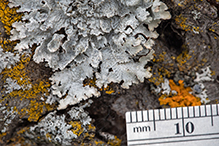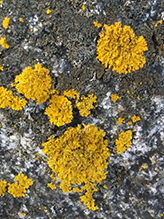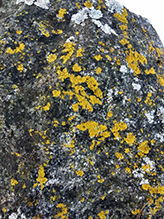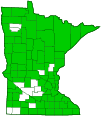Powdery Sunburst Lichen
(Xanthomendoza ulophyllodes)
Conservation • Description • Ecology • Distribution • Taxonomy
Conservation Status |
|||
| IUCN Red List | not listed |
||
| NatureServe | NNR - Unranked SNR - Unranked |
||
| Minnesota | not listed |
||
Description
Powdery Sunburst Lichen is a common and widespread lichen. It occurs in Europe, western Asia, and North America. It occurs throughout the United States, but it is mostly absent from the Great Plains and the Great Basin. It is very common in Minnesota.
Powdery Sunburst Lichen grows on bark and occasionally on rock and on concrete. It is commonly found on cemetery headstones.
The vegetative body (thallus) is leaf-like (foliose) and divided into small branches (lobes). It forms rosettes up to 1⅜″ (3.5 cm) wide, sometimes larger. The rosettes sometimes coalesce to cover much larger areas. It grows loosely attached to the substrate.
The lobes are flat to convex, flat (truncate) to round at the tip, up to 3 ⁄16″ (5 mm) long, sometimes longer, and 1 ⁄64″ to 1 ⁄16″ (0.3 to 1.5 mm) wide. They are semi-erect when fresh, becoming flattened with just the tips ascending in the older parts. The upper surface is smooth to shiny and deep orange when exposed to the sun, orange to yellowish orange in partially shaded areas, and pale yellow or greenish yellow in deep shade. There are tiny, globular chambers (pycnidia) embedded in the thallus with an opening through which fungal spores are released. The pycnidia are darker than the upper surface. The lower surface of the thallus is white and smooth to somewhat wrinkled. There are abundant, white to yellow, root-like structures (rhizines) attaching the lower surface to the substrate. The upper and lower surfaces of the lichen are formed of tightly packed, interwoven, fungal threads (hyphae) going in all directions (paraplectenchymatous).
Disk-like, spore-producing structures (apothecia) are rare, but when present they may be abundant. They are orange, stalked, up to ⅛″ (3 mm) in diameter, and shaped like a plate.
Similar Species
Ecology
Substrate
Bark, rock, cement
Growth Form
Foliose
Habitat
Hosts
Distribution |
||
|
Sources Biodiversity occurrence data published by: Minnesota Biodiversity Atlas (accessed through the Minnesota Biodiversity Atlas Portal, bellatlas.umn.edu, 12/9/2025). |
|
| 12/9/2025 | ||
Occurrence |
||
Very common |
||
Taxonomy
Kingdom
Fungi (Fungi)
Subkingdom
Dikarya
Phylum
Ascomycota (Sac Fungi)
Subphylum
Pezizomycotina (Sac Fungi and Lichens)
Class
Lecanoromycetes (Common Lichens)
Subclass
Lecanoromycetidae (Shield Lichens, Sunburst Lichens, Rosette Lichens, and Allies)
Order
Teloschistales (Sunburst Lichens and Allies)
Suborder
Teloschistineae
Family
Teloschistaceae (Sunburst Lichens, Firedots, and Allies)
Subfamily
Xanthorioideae
Genus
Xanthomendoza
Mycobiont
Xanthomendoza ulophyllodes
Photobiont
green algae other than Trentepohlia
Subordinate Taxa
Powdery Sunburst Lichen (Xanthomendoza ulophyllodes var. subsorediosa)
Powdery Sunburst Lichen (Xanthomendoza ulophyllodes var. ulophyllodes)
Synonyms
Oxneria coppinsii
Oxneria ulophyllodes
Xanthoria soechtingii
Xanthoria ulophyllodes
Common Names
Powdery Sunburst Lichen
Glossary
Apothecium
An open, disk-shaped or cup-shaped, reproductive structure, with spore sacs on the upper surface, that produces spores for the fungal partner of a lichen. Plural: apothecia.
Foliose
Leaf-like; referring to lichens with thin, flat, leaf-like growths divided into lobes which are free from the substrate.
Hypha
A thread-like cell of a fungus that is the main mode of vegetative growth: the basic structural unit of a multicellular fungus. Plural: hyphae. Collectively, the hyphae of a fungus is the mycelium.
Pycnidium
A small, spherical, flask-shaped, or inversely pear-shaped, asexual reproductive structure produced by fungi in which conidia develop. Plural: pycnidia.
Rhizine
A root-like structure of a lichen that attaches the lower layer to the substrate.
Rosette
A radiating group or cluster of leaves usually on or close to the ground.
Thallus
In lichens: The vegetative body of a lichen composed of both the alga and the fungus. In liverworts: a flat, relatively undifferentiated plant body. Plural: thalli.
Truncate
Terminating abruptly as if cut off, as with a leaf base.
Visitor Photos
Share your photo of this lichen.
This button not working for you?
Simply email us at info@MinnesotaSeasons.com.
Attach one or more photos and, if you like, a caption.
Ray Fraley |
 |
Luciearl |
||
lichen on rock |
||
 |
 |
|
MinnesotaSeasons.com Photos
|

Slideshows

Visitor Videos
Share your video of this lichen.
This button not working for you?
Simply email us at info@MinnesotaSeasons.com.
Attach a video, a YouTube link, or a cloud storage link.
Other Videos



